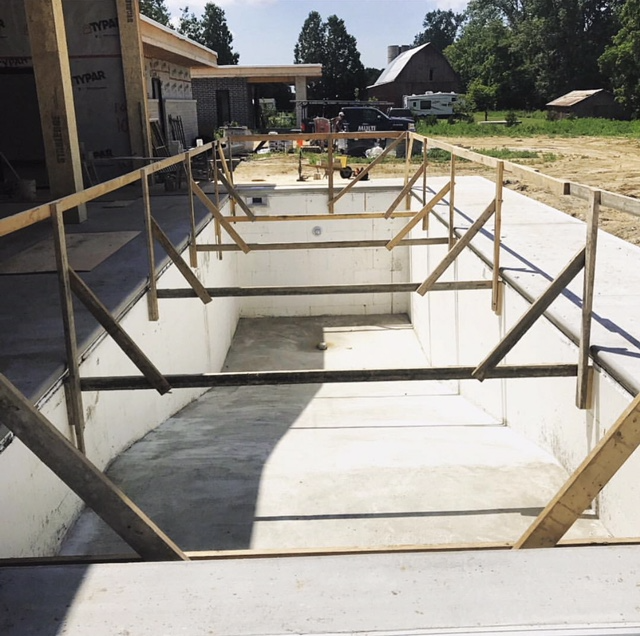
Swimming Pool Engineering and a Great Material to Utilize

Nothing makes summertime more enjoyable than a beautiful swimming pool. Although swimming pools are a great way to spend hot summer days, installing a swimming pool is a serious investment and you want to know that it has been designed correctly. Well-designed swimming pools will last a long time with little maintenance and lower energy bills.

How Do You Build a Pool?
Designing a pool can be fairly straightforward, especially when working with an experienced builder. The three main aspects are: where to put it, what’s the shape, and what will it be made out of?
Pool Location
Before building a swimming pool, you have to decide where to put it. Choosing a location with easy access to the house or a pool house makes entertaining and using the pool much more fun. If the pool will have to be built away from other structures, make sure to have a nice, well-lit path to maintain easy access.
When choosing the location, consider the pool deck area as well. Having sufficient room around the pool makes using the pool much more enjoyable. Consider the things you will want to have close to the pool like lounge chairs, or an outdoor kitchen area.
Pool Shape
Pools come in a wide range of sizes from small swim spas to Olympic-size pools. Large pools are great for entertaining but they cost more to install and maintain.

Many pools are rectangular, but this does not always have to be the case. Pools that are not rectangular can give the yard a more relaxed look and tend to be more inviting. Design the pool shape, size, and depth to meet your budget and desired outcome.
Pool Construction
The materials used in pool construction have evolved over the decades as new, more efficient ways to build pools have been developed. The type of construction you choose will arguably be the most important aspect because of the price and the cost to maintain the pool over time.
Some of the most common pool construction materials available are:
Vinyl
Fiberglass
Shotcrete
Gunite
Insulated Concrete Forms (ICF)
Common Pool Building Materials
Installing a swimming pool is a big investment, and you want to make sure that it is done correctly. Well-built pools will last for many years with little maintenance and low energy bills. There are several methods for constructing swimming pools, each with its own benefits and drawbacks.
Vinyl
Although vinyl pools are no longer as popular as some of the other types of swimming pools, they have many benefits that make them a good choice for homeowners. Vinyl pool construction is very affordable which makes it a budget-friendly option for many homeowners.
Vinyl pool construction is also typically very durable and can withstand even the most extreme weather conditions, so it is probably a good choice for homeowners in areas where the weather can be unpredictable.
Fiberglass
Fiberglass pools are popular because they come pre-molded in a variety of different shapes and sizes. Steps, benches, and swim-outs are prefabricated and no framing on site is required.
Fiberglass pools have become a popular choice for homeowners in part because of their affordability—fiberglass pools are often less expensive than other types of pools—and their durability. Fiberglass is a very strong material and it can take a fair amount of wear. Unlike some other types of pools, fiberglass does not require regular acid washing or chlorine treatments.
Gunite and Shotcrete
Gunite and shotcrete are made by mixing cement, sand, and water together and spraying the mixture at high velocities against earthen walls. Rebar is laid against the wall and it gets encased by shotcrete. Shotcrete comes delivered premixed in a truck, while gunite stays dry until it reaches the spray nozzle.
Both application methods have their pros and cons, but they both require skilled labor to apply the material. Multiple passes are needed to build up a thick enough layer. Good pools can last for a very long time and can be low- maintenance, but they must be built properly.
Insulated Concrete Forms
Insulated Concrete Forms (ICF) come as blocks made of layers of insulation on the inside and outside that form a hollow space in between that can be filled with concrete and rebar. The blocks are placed in the pool area and then filled with concrete to help to insulate the pool and keep the water warmer.

ICF blocks can be installed by less-skilled labor and are much more forgiving of errors. ICF swimming pools require less maintenance than other pool types which makes it a good option for busy homeowners who do not have time to spend on regular maintenance tasks. As a result, ICF blocks are an important part of many swimming pool engineering projects.
ICF Blocks: The Best Choice for Swimming Pool Designs
ICF blocks are a popular choice for swimming pool construction and engineering projects, and for good reason. They may cost more than traditional pool construction materials like steel frame and vinyl or fiberglass, but they provide a number of advantages. ICF blocks are extremely strong and durable, which makes them ideal for supporting the weight of a pool. They also provide excellent insulation, and help keep the water warm in cooler weather.
Traditional pool finishing material may be applied over the ICF wall - vinyl, tile, stucco plaster, etc.

In addition, ICF blocks are easy to work with and can be cut to any size or shape. They are lightweight, so ICF blocks are easy to install, which keeps labor costs low. As a result, they are a versatile solution for any swimming pool engineering project.
If you’re considering building a new swimming pool, be sure to reach out to the experts at Fox Blocks today to learn more about why ICF blocks are the best option!